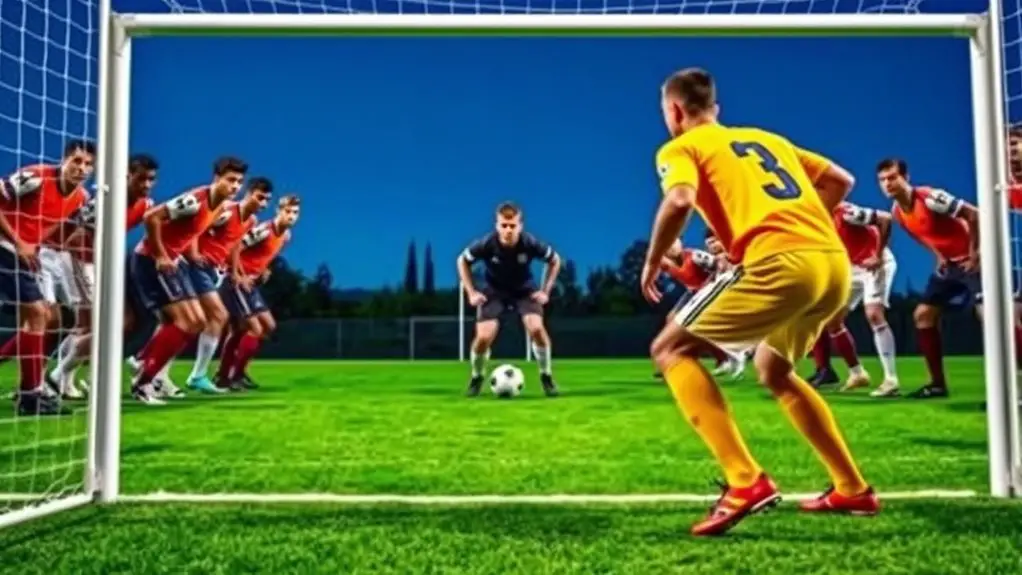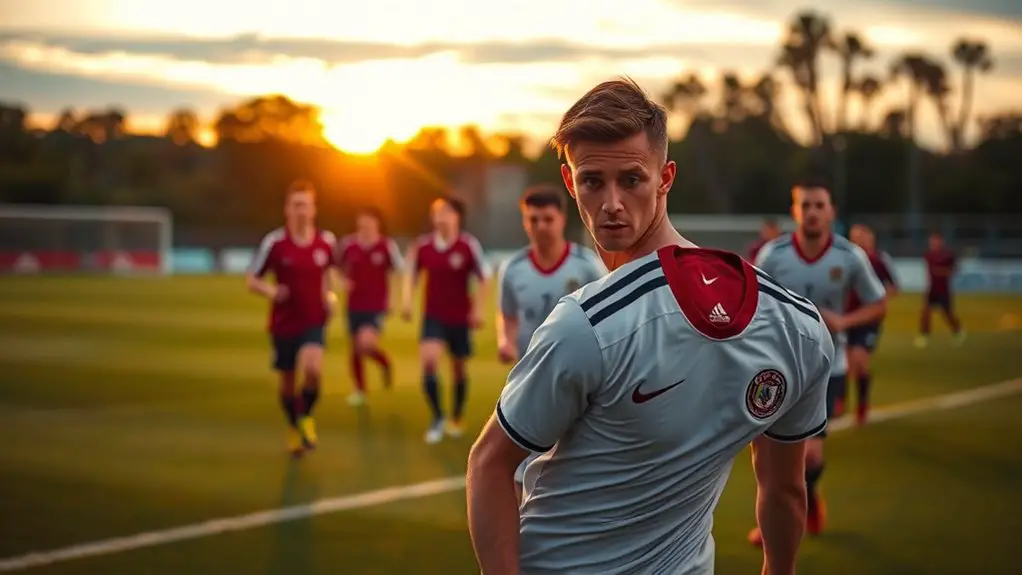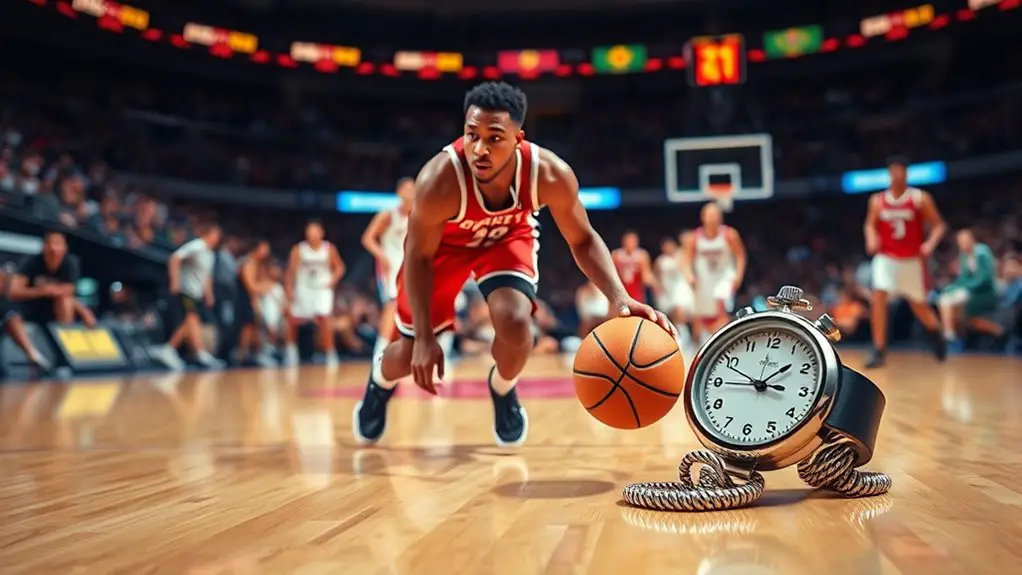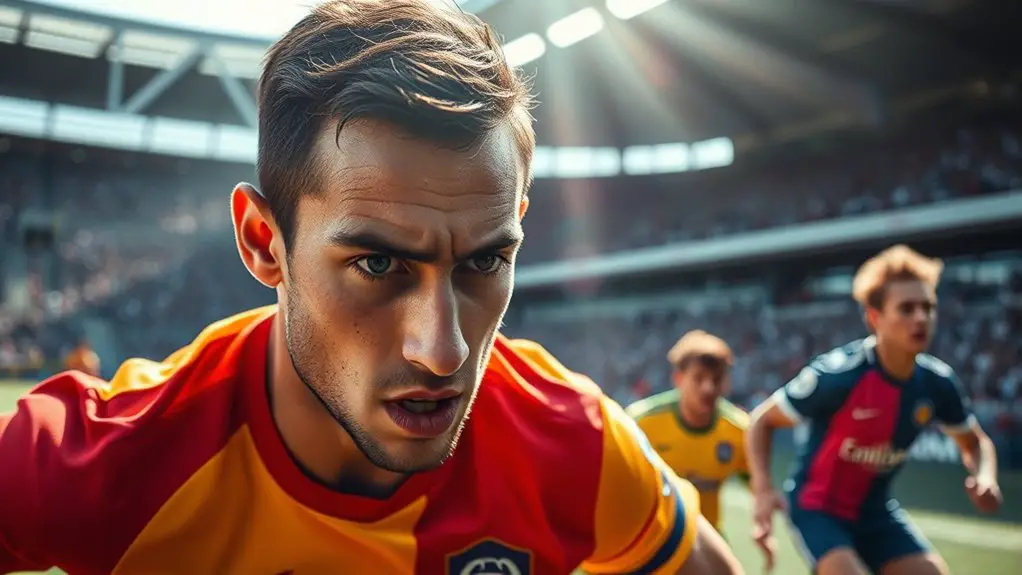To develop elite defensive positioning and anticipation, focus on key principles like effective spacing and recognizing opponent behavior. Cultivating observation skills and body language analysis helps you predict their moves. Regular drills, such as shadowing and agility training, build your footwork and positioning. Mental strategies, including visualization and mindfulness, sharpen your instincts. By honing these skills, you'll outsmart opponents in real-time. Stick around to discover strategies that can elevate your game even further.
Understanding the Importance of Defensive Positioning
When you think about successful defense, it's clear that positioning plays an essential role in anticipating your opponent's moves. Effective defensive spacing allows you to create a buffer, giving you time to react. By mastering positioning strategies, you can disrupt your opponent's flow and gain the upper hand.
Imagine standing in the right spot, where you can see every angle of the game. You don't just react; you predict, guiding your body and mind to the ideal defensive stance. This awareness of space empowers you to defend with confidence and freedom. Additionally, enhancing your strength and conditioning can significantly improve your agility, allowing for quicker adjustments in defensive positioning.
Key Principles of Effective Anticipation
Although anticipation might seem like an instinctive skill, it's rooted in a few key principles that can be developed through practice. To enhance your defensive awareness, start by honing your observation skills. Pay close attention to your opponent's body language and movements; this will help you identify potential plays before they unfold.
Next, incorporate various anticipation techniques, like predicting passing lanes or recognizing patterns in your opponent's behavior. By doing this, you can position yourself effectively to counter their moves.
Finally, embrace the importance of mental agility. Stay flexible and ready to adjust your strategies based on real-time cues. Developing these principles will not only elevate your game but also grant you the freedom to react instinctively when it matters most. With dedication and practice, you'll find your anticipation skills sharpening, empowering you to dominate defensively. Additionally, practicing mindfulness techniques can help you maintain focus and composure during high-pressure situations.
Analyzing Opponent Behavior
To effectively analyze your opponent's behavior, you'll want to pay close attention to their body language. Often, subtle cues can reveal their intentions and help you predict their movement patterns. By honing this skill, you can stay one step ahead in any competitive situation. Additionally, incorporating mindfulness in athletic performance can further enhance your ability to remain present and engaged, allowing for quicker reactions to your opponent's actions.
Reading Body Language
How can you effectively read your opponent's body language to gain a tactical advantage? Understanding nonverbal cues and facial expressions can reveal a lot about what your opponent might do next. Here are three key aspects to focus on:
- Posture: An open stance might indicate confidence, while a closed posture could signal hesitation or fear.
- Eye Movement: Watch where they look; darting eyes may suggest nervousness or indecision, while focused eyes can show intent.
- Facial Expressions: Subtle changes, like a quick frown or raised eyebrows, can hint at their next move or reaction.
Predicting Movement Patterns
By analyzing your opponent's behavior, you can start to predict their movement patterns, which can give you a significant edge in any competitive scenario. Movement prediction relies heavily on your spatial awareness. Observe how they shift their weight, their foot placement, and even their gaze. These subtle cues often reveal their next move.
Developing this skill takes practice, but once you've mastered it, you'll feel empowered. You won't just react; you'll anticipate. Think about your own movements, too—how you'd try to outmaneuver them. This awareness not only sharpens your defense but also enhances your offensive strategies. By predicting their movements, you can seize control of the game, turning their actions into your opportunities for success.
Drills to Enhance Defensive Skills
While mastering defensive skills takes time and practice, incorporating specific drills can greatly elevate your game. Here are three effective drills to sharpen your defensive prowess and promote defensive teamwork:
- Shadowing Drill: Pair up with a teammate and have one player move in various directions while the other shadows them. This drill builds anticipation and encourages you to stay close to your opponent.
- Defensive Slide Drill: Set up cones in a zigzag pattern. Slide laterally between them, focusing on maintaining a low stance and quick footwork. This drill variation helps improve your lateral movement and positioning.
- 1-on-1 Situational Drill: Create scenarios with a partner where one attacks and the other defends. Rotate roles frequently to practice both defending and anticipating the attack.
Incorporating these drills into your routine will not only enhance your skills but also foster a stronger connection with your teammates on the court. Additionally, integrating agility ladder drills can further improve your foot speed and coordination, which are essential for effective defensive positioning.
The Role of Footwork in Defense
Effective defense hinges on your footwork, as it allows you to quickly react to your opponent's movements. Proper foot placement is essential; it helps you maintain balance and control while staying agile. Incorporating agility training into your routine will enhance your ability to shift directions effortlessly, making you a more formidable defender. Additionally, focusing on proper footwork can significantly reduce the risk of injuries during high-intensity gameplay.
Here's a quick reference table to illustrate key aspects of footwork in defense:
| Aspect | Description |
|---|---|
| Foot Placement | Position feet shoulder-width apart for balance. |
| Agility Training | Drills like ladder exercises boost quickness. |
| Weight Distribution | Keep your weight on the balls of your feet. |
| Reaction Time | Practice responding to various movements. |
| Body Alignment | Align your hips and shoulders with your target. |
Utilizing Body Positioning for Maximum Effect
Footwork lays the groundwork for solid defense, but how you position your body can amplify your effectiveness on the court. Mastering your body angles and space management is essential. Here are three key strategies to enhance your defensive positioning:
Effective defense relies on footwork and body positioning; mastering angles and space is key to success on the court.
- Stay Low: Bend your knees and keep your center of gravity low. This helps you react quickly and maintain balance while adjusting to your opponent's movements.
- Angle Your Body: Position yourself at an angle to your opponent. This not only makes it harder for them to drive past you but also allows you to cut off potential passing lanes.
- Watch Your Space: Be aware of the space around you. Maintain a proper distance to avoid getting too close, which can lead to fouls or being beaten off the dribble. Additionally, incorporating mobility training techniques can further enhance your agility and responsiveness on the court.
Mental Strategies for Anticipating Moves
To master the art of anticipating moves, you'll want to harness the power of visualization techniques and develop your pattern recognition skills. By picturing different scenarios in your mind, you can prepare yourself for what might come next. Recognizing patterns in your opponent's behavior will further sharpen your instincts and decision-making. Additionally, incorporating mindfulness techniques into your training can enhance your focus and presence during competitions.
Visualization Techniques
While mastering defensive positioning, incorporating visualization techniques can greatly enhance your ability to anticipate your opponent's moves. By engaging in visualization exercises, you can train your mind to foresee various scenarios, leading to quicker reactions. Here are three effective techniques to try:
- Mental Imagery: Picture yourself in a game situation, predicting your opponent's actions and planning your response.
- Scenario Rehearsal: Visualize different game situations and how you'd position yourself defensively, preparing for possible outcomes.
- Reflection: After games, mentally replay key moments, focusing on what you could've done differently to improve your anticipation skills.
These strategies not only sharpen your instincts but also empower you to take control of your performance, embracing the freedom to adapt in any match.
Pattern Recognition Skills
Recognizing patterns in your opponent's behavior can greatly enhance your ability to anticipate their moves. By honing your pattern identification skills, you'll tap into the art of cognitive processing, allowing you to read situations instinctively. Pay attention to their tendencies—do they always shift left when under pressure? Are they predictable in their reactions? This awareness gives you the freedom to preempt their actions and position yourself effectively. Practice observing not just the physical movements, but also the emotional cues that might reveal their next step. The more you engage in this mental exercise, the sharper your anticipation becomes, empowering you to react swiftly and decisively, ultimately elevating your defensive game to a whole new level.
Incorporating Video Analysis Into Training
Incorporating video analysis into training can greatly enhance your understanding of defensive positioning and anticipation. By using video breakdowns, you can observe your movements and decisions in real-time, which is essential for improvement. Here are three ways to effectively integrate video analysis into your training:
- Review Game Footage: Analyze past games to identify patterns in your defensive play. Look for moments where positioning could've been better.
- Receive Performance Feedback: Share your video with coaches or teammates to get constructive criticism. Their insights can highlight areas you might overlook.
- Set Goals: Use video to track your progress over time. Setting specific goals based on your analysis can keep you motivated and focused. Additionally, incorporating reaction time drills into your training can lead to improved anticipation and responsiveness during games.
Building a Defensive Mindset: Tips for Athletes
Building a defensive mindset is essential for athletes who want to excel in their sport, especially on the field or court. Embracing this mentality not only enhances your performance but also shifts your athlete psychology, allowing you to anticipate opponents' moves effectively. Here are some tips to help you foster this mindset:
| Tip | Description |
|---|---|
| Stay Aware | Always keep your head on a swivel to observe plays. |
| Visualize Scenarios | Imagine different game situations to prepare mentally. |
| Focus on Footwork | Good positioning starts with quick, agile movements. |
| Communicate | Talk with teammates to maintain strong defensive coordination. |
| Reflect & Adjust | After each game, analyze your decisions and improve. |
Additionally, incorporating mindfulness techniques can help athletes remain focused and calm during intense moments in a game.
Frequently Asked Questions
How Can I Improve My Reaction Time During Defensive Plays?
How often do you think about your reaction time during defensive plays? To improve it, you should incorporate reaction drills into your training routine. These drills can sharpen your instincts and speed. Additionally, agility training can enhance your overall quickness, allowing you to respond to opponents more effectively. By combining these techniques, you'll find your ability to anticipate plays and react swiftly will markedly improve, giving you the edge you desire on the field.
What Common Mistakes Do Athletes Make in Defensive Positioning?
When it comes to defensive positioning, many athletes make common mistakes that hinder their performance. You might struggle with poor footwork or lack awareness of your surroundings, leading to misjudged angles. Overcommitting tackles can leave you vulnerable, while improper spacing can disrupt your defensive flow. Additionally, inadequate communication with teammates often results in confusion. By addressing these issues, you can enhance your defensive skills and create a more effective game strategy.
How Does Fatigue Impact Defensive Effectiveness?
Imagine a warrior in a fierce battle, their strength waning as fatigue sets in. Just like that warrior, you need to manage fatigue effectively to maintain your defensive prowess. When you don't prioritize muscle recovery, your movements become sluggish, leaving you vulnerable. A tired body lacks the agility to anticipate opponents' next moves, ultimately compromising your defensive effectiveness. Embrace recovery, and you'll find the freedom to defend with agility and precision.
Can Nutrition Influence Defensive Performance and Anticipation?
Absolutely, nutrition can greatly influence your defensive performance and anticipation. By focusing on nutritional timing, you guarantee your body has the right energy levels for peak performance. Hydration strategies are equally vital; staying well-hydrated keeps your reflexes sharp and your mind alert. When you fuel your body properly, you're not just enhancing stamina but also improving your ability to read the game and react effectively. It's all about setting yourself up for success!
What Mental Exercises Enhance Defensive Instincts?
You might've heard that mental exercises can seriously boost your defensive instincts. Visualization techniques, where you picture yourself in different game scenarios, can sharpen your anticipation. Couple that with mindfulness practices to keep you present and focused, and you're on your way to enhancing your instincts. By freeing your mind from distractions, you'll be more aware of your surroundings, making you a more formidable defender on the field.




